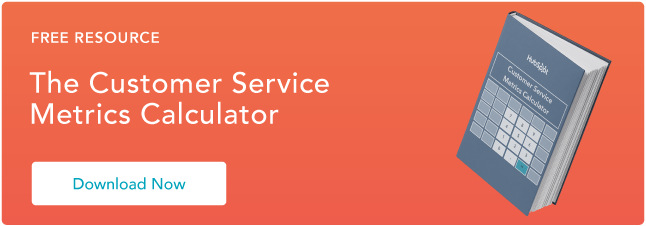My "guilty pleasure" TV show is Antiques Roadshow. Growing up, my family would guess the value of objects and the winner would be the one who was closest to the expert's appraisal. We were pretty good at it too, but there were always a few items that shocked us when the price tag was revealed.

Antiques Roadshow is an excellent example of customer value. The expert would thoroughly explain why a buyer would want a certain piece and why the benefits were worth its cost. While the fun part was trying to beat the expert to the price, this concept outlines the basic principles of customer value.
In this post, let's take a look at customer value, including what it is and how to calculate it for your customer base. Then, we'll wrap up by providing some tips that enhance value using your customer service and success team.
What Is Customer Value?
Customer value measures a product or service's worth and compares it to its possible alternatives. This determines whether the customer feels like they received enough value for the price they paid for the product/service.
We can look at customer value as insight into buyer's remorse. If customers feel like the total cost of an item outweighs its benefits, they're going to regret their purchase. Especially if there's a competitor who's making a better offer than yours for a similar product or service.
Understanding customer value and how to calculate it can help your business price products fairly and reduce friction within the customer experience.
Customer Value Added
For some businesses, customer value boils down to dollars and cents. However, it's important to remember that customers give more to your company than just what's listed on the price tag. There are also time costs, energy costs, and emotional costs that customers weigh when making a buying decision.
Similarly, there are different types of benefits that influence customer decisions. Some examples include tangible benefits — like how the product will help them achieve goals — as well as image benefits — like how owning this product or service will change one's social status in the eyes of their peers and colleagues.
To measure customer value, we first need to recognize these different types of costs and benefits. The graphic below can help by summarizing the factors you should be addressing when calculating customer value.
-1%20(1).webp?width=520&height=604&name=What%20Is%20Customer%20Value_%20(%26%20How%20Your%20Business%20Can%20Generate%20It)-1%20(1).webp)
How to Measure Customer Value
- Identify customer benefits.
- Total customer costs.
- Find the difference between customer benefits and customer costs.
1. Identify customer benefits.
While the graphic above highlights some general benefits, here are some specific one you can consider:
- The quality of your product or service
- The ability to provide a better solution
- Your brand's reputation
- Your unique customer experience
- The quality of your customer service team
- The social advantages of partnering with your business
2. Total customer costs.
When measuring customer costs, it helps to differentiate between tangible and intangible. That way you can calculate the total of your monetary costs and compare it to your other costs.
Tangible Costs:
- The price of your product or service
- Installation or onboarding costs
- The cost of accessing your product or service
- Maintenance costs
- Renewal costs
Intangible Costs:
- Time invested in buying your product or service
- A poor customer experience
- Physical or emotional stress induced from buying or installing your product
- A poor brand reputation
- Time spent understanding how your product or service works
3. Find the difference between customer benefits and customer costs.
To calculate customer value, we can use the equation below.
Customer Value Formula
The formula for customer value can be written as: (Total Customer Benefits - Total Customer Costs) = Customer Value, or (B - C = CV).
.webp?width=700&height=525&name=What%20Is%20Customer%20Value_%20(%26%20How%20Your%20Business%20Can%20Generate%20It).webp)
However, it's important to note that since you're working with tangible and intangible elements, this formula won't look like your typical math equation. You'll need to determine how much benefits like brand reputation, social status, and service convenience are worth compared to costs like time investment, emotional stress, and physical commitment.
Additionally, customer value is going to vary depending on the segment of customers you're analyzing. Since each person is different and has specific needs, goals, and expectations, you might find the definition of "good value" is inconsistent. If you do, try segmenting your customer base into different buyer personas, then calculate customer value for each group.
Now that we're familiar with customer value and how to calculate it, let's look at some ways you can generate it through customer service.
Tips for Increasing Customer Value
- Evaluate your customer experience.
- Focus on more than price.
- Collect customer data.
- Target your most loyal customers.
- Segment your customer base.
1. Evaluate your customer experience.
When increasing customer value, the best place to start is by analyzing your customer experience. Create a customer journey map that outlines each step your customers take when buying something from your business and look for interactions that might cause friction within the experience. Once you can visualize every action your customers are taking, it's easier to identify opportunities to add value.
2. Focus on more than price.
For some businesses, it's tough to compete through price alone. Sometimes the cost to make a product is static, and there's not much room for a business to lower its price tag.
But, that doesn't mean you can't create a competitive offer in your industry.
This is where you should look for alternative ways to add value to your customer experience. Keep in mind that customer needs range from convenience to performance and there are plenty of non-monetary benefits that can convince people to buy your product.
3. Collect customer data.
It's hard to make effective changes if you're only looking at customer value from the business perspective. Instead, you should be centering your focus on the customer's perceived value of your product or service.
To do that, you'll need access to quantitative and qualitative customer data. With it, management teams will have facts and statistics that justify their proposed changes. Leadership can make decisions confidently knowing their perception of customer value aligns with your customer base.
Additionally, it's important to collect both quantitative and qualitative data as this will give you a diverse data set that includes insightful statistics and captures the voice of the customer.
4. Target your most loyal customers.
You might think that because a customer is loyal, they're already receiving value from your business. And, you'd be right.
However, just because someone is loyal to your business, that doesn't mean you can't — or shouldn't — outsize their customer value. Encompassing additional benefits through customer loyalty programs can generate even more value for these customers.
While this approach not only retains your most valuable audience, it acquires new customers as well. For example, you can leverage benefits in exchange for customer advocacy. Have customers submit feedback or write a testimonial that shares their positive experience with potential leads. Since 93% of consumers use reviews when making buying decisions, this will add another benefit to your customer value equation.
5. Segment your customer base.
As we mentioned earlier, customer value can vary depending on who you're surveying, and a customer's needs and goals will influence their definition of "value." Since not all customers are alike, this creates discrepancies when measuring value at your business.
That's why it's important to segment your customer base into specific target audiences. Start with your buyer personas and use customer data to identify specific purchasing behaviors. Once your groups are established, you can measure customer value for each.
Customer value is important to track, but it's not as easy as inputting numbers into a simple formula. It's all about measuring tangible benefits and perceived value in addition to the actual cost of a product.
Editor's note: This post was originally published in March 2020 and has been updated for comprehensiveness.
![→ Download Now: Customer Service Metrics Calculator [Free Tool]](https://no-cache.hubspot.com/cta/default/53/e24dc302-9dc2-466f-a5ca-ab4e08633c0f.png)

![10 Customer Onboarding Challenges You Might Face This Year [+Expert Tips]](https://knowledge.hubspot.com/hubfs/ai%20customer%20service%20predictions%20%282%29.webp)

![Advocacy Marketing: How to Do It Well in 2024 [Strategies + Examples]](https://53.fs1.hubspotusercontent-na1.net/hubfs/53/customer-advocacy.jpg)




![What To Do if Someone Threatens to Sue You [+Customer Service Lawsuit Tips]](https://www.hubspot.com/hubfs/196_Customer-Service-Lawsuit-Tips.png)

